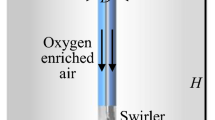Timely and full tapping of liquid smelting products is an important condition for forcing the blast-furnace process. Unstable tapping of iron and slag leads to fluctuations of the liquid level in the hearth, changes in the charging rate, and fluctuations in the time the burden stays in the blast furnace. This, in turn, affects the thermal state and the composition of the liquid products. The ratio of tapped slag weight to the hot metal weight is determined by the physical properties of slag and the length and diameter of the taphole. An analysis of the operation of the EVRAZ NTMK blast furnaces revealed substantial fluctuations of this ratio. When the volume of tapped slag is 340 to 360 kg per ton of pig iron, the slag/metal weight ratio is between 200 and 850 kg per ton of pig iron. The objective is to analyze the causes of unstable tapping and the effect of the instability on the furnace performances using the laws of fluid mechanics. It is assumed that the melt flow in the taphole is stratified. The effect of the slag properties and the dimensions of the taphole on the velocity of the melt and, hence, on the slag/metal weight ratio in the taphole is studied. Since the velocity of the melt depends on its physical properties, a mathematical model was developed to assess the slag/metal weight ratio from the viscosity of the slag and the dimensions of the taphole. The results of modeling are validated against the industrial data acquired by the EVRAZ NTMK. It was established that an increase in the tapped slag/metal weight ratio leads to worse performance and lower vanadium recovery from pig iron.







Similar content being viewed by others
References
L. Shao and H. Saxen, “A simulation study of blast furnace hearth drainage using a two-phase flow model of the taphole,” ISIJ Int., 51, No. 2, 228–235 (2011).
J. Muller, J. H. Zietsman, and P. C. Pistorius, “Modeling of manganese ferroalloy slag properties and flow during tapping,” Metallurg. Mater. Trans. B: Process Metallurg. Mater. Proc. Sci., 46, No. 6, 2639–2651 (2015).
K. Nishioka, T. Maeda, and M. Shimizu, “A three-dimensional mathematical modelling of drainage behavior in blast furnace hearth,” Tetsu-To-Hagane, J. Iron and Steel Institute Japan, 92, No. 12, 967–975 (2006).
M. Iida, K. Ogura, and T. Hakone, “Analysis of drainage rate variation of molten iron and slag from blast furnace during tapping,” ISIJ Int., 48, No. 4, 412–419 (2008).
T. Yamamoto and Y. Toritani, “Al2O3 mud to decrease blast furnace tapping frequency,” Iron and Steel Engineer, No. 6, 56–61 (1990).
H. Abramowitz, L. J. Goffney, and W. L. Ziegert, “Taphole mix properties and performance for the first year of operation on Inland’s No. 7 blast furnace,” in: Proc. 42nd Ironmaking Conf. (Atlanta, GA, April 17–20, 1983) Iron and Steel Society of AIME, Warrendale, PA (1983), pp. 681–694.
H.-P. Ruther and H.-B. Lungen, “Refractory technology and operational experience with tapholes and troughs of blast furnaces in the Federal Republic of Germany,” Metallurgical Plant and Technology, No. 3, 12–29 (1989).
L. Wells, The Rheology of a Composite Polymer Ceramic Plastic Refractory, Department of Materials Engineering, University of Wollongong (2002); https://ro.uow.edu.au/theses/1533
V. S. Shvydkii (ed.), Yu. G. Yaroshenko, Ya. M. Gordon, et al., Fluid Mechanics [in Russian], Akademkniga, Moscow (2003).
E. V. Ametistov, V. A. Grigor’ev, B. T. Emtsev, A. V. Klimenko, et al., Theoretical Foundations of Thermal Engineering. Thermal Experiment (Manual) [in Russian], Energoatomizdat, Moscow (1988).
I. D. Balon et al., Ore Preparation and Blast-Furnace Process, Part 1 of the two-volume Blast-Furnace Practice Handbook, Metallurgiya, Moscow (1989).
A. K. Mitropolsky, Statistical Calculation Technique [in Russian], Nauka, Moscow (1971).
S. M. Dukarskii, Thermometry of Products of Blast-Furnace Smelting [in Russian], Metallurgiya, Moscow (1976).
J. Brannbacka and H. Saxen, “Modeling the liquid levels in the blast furnace hearth,” ISIJ Int., 41, No. 10, 1131–1138 (2001).
I. P. Fedorov and S. F. Bugaev, “Optimizing the tapping regime on a blast furnace operating at variable speed,” Metallurgist, 50, No. 9–10, 519–524 (2006).
K. V. Mironov, V. A. Mikhalev, K. B. Pykhteeva, and B. S. Tleugabulov, “Analyzing the behavior of vanadium in the conditions of intensive blast-furnace smelting,” Chern. Metally, No. 1, 23–29 (2018).
Author information
Authors and Affiliations
Corresponding author
Additional information
Translated from Metallurg, Vol. 64, No. 2, pp. 18–22, February, 2020.
Rights and permissions
About this article
Cite this article
Panteleev, V.V., Mironov, K.V., Zagainov, S.A. et al. Effect of Unstable Tapping of Smelting Products on the Performances of the Evraz Ntmk Blast Furnaces. Metallurgist 64, 93–99 (2020). https://doi.org/10.1007/s11015-020-00970-5
Received:
Published:
Issue Date:
DOI: https://doi.org/10.1007/s11015-020-00970-5




